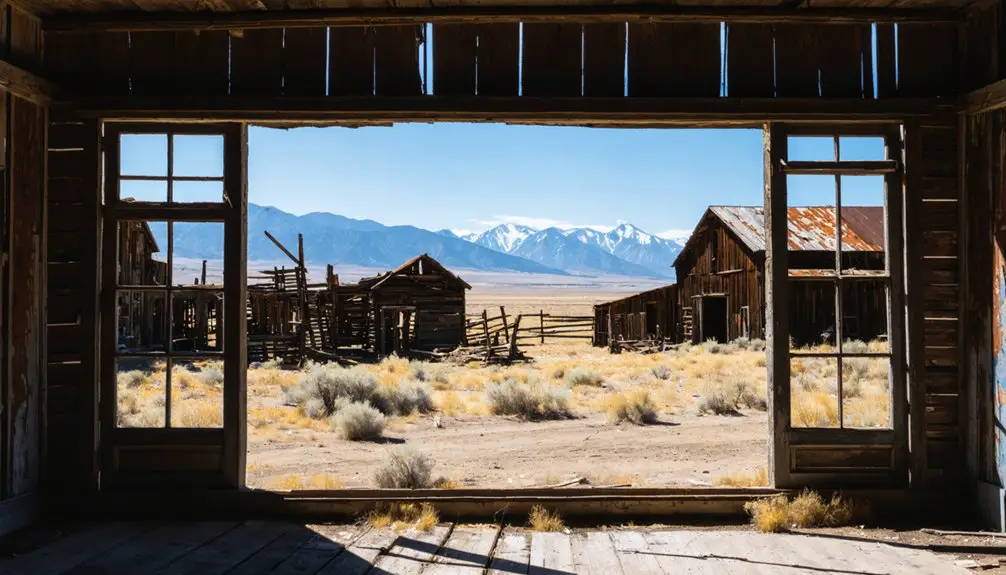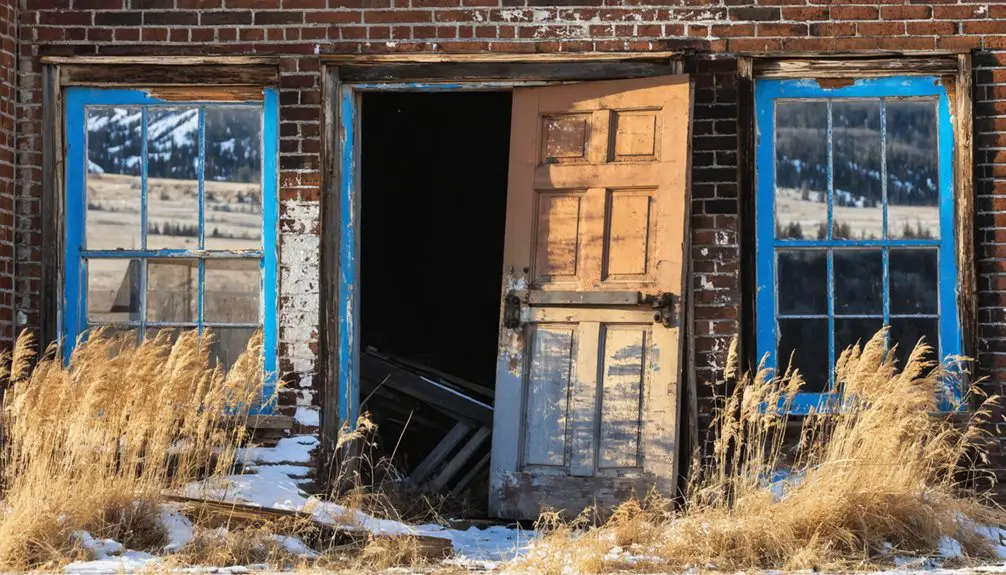You’ll find Square Butte, Montana, established in 1864, as a once-thriving mining camp that evolved into a significant industrial center in Montana’s Silver Bow Creek Valley. The town flourished atop the Boulder Batholith’s rich mineral deposits, with the 1874 Asteroid Mine discovery leading to advanced underground operations. While the Milwaukee Road Railway connected this bustling community to wider markets, the shift to open-pit mining by 1955 hastened its decline. The remnants and legends of this historic mining town hold countless untold stories.
Key Takeaways
- Square Butte originated as an 1864 mining camp in Montana’s Silver Bow Creek Valley, built upon rich mineral deposits in the Boulder Batholith.
- The town flourished after the 1874 Asteroid Mine discovery, reaching peak copper production of 210 million pounds annually by 1896.
- Diverse immigrant communities established distinct neighborhoods, schools, and churches during the town’s prosperous mining era.
- The town declined due to mineral depletion, shifting from underground to open-pit mining, and fluctuating copper prices post-World War I.
- Historical remnants include building foundations, shaft covers, and the still-operational Square Butte Country Club Bar.
Historical Development of Square Butte
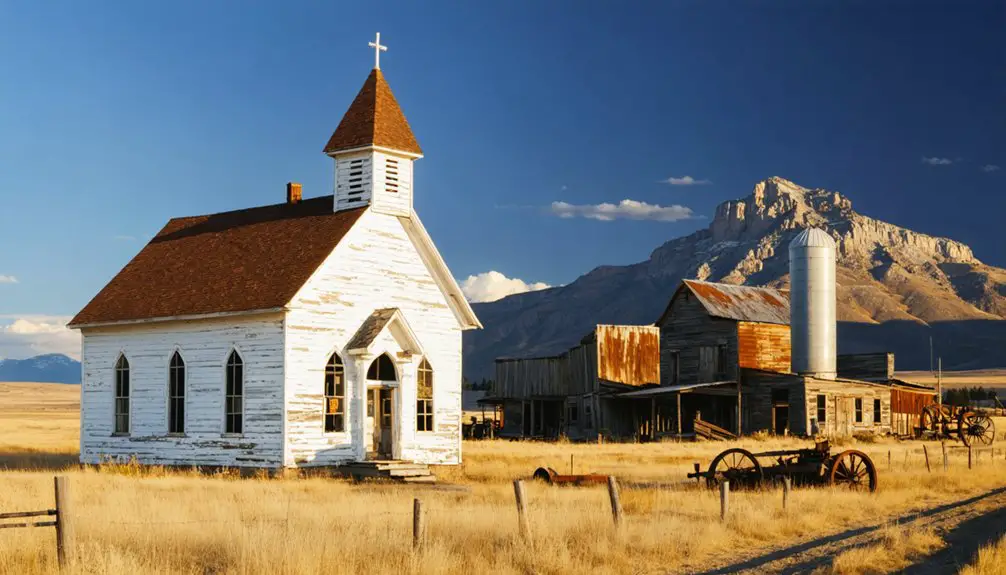
Although Square Butte began as a modest mining camp in 1864, it quickly transformed into a thriving industrial hub within Montana’s Silver Bow Creek Valley.
From humble mining origins in 1864, Square Butte emerged as a powerhouse of industry in Montana’s Silver Bow Valley.
The town’s historical significance emerged from its position atop the Boulder Batholith, a massive granite formation that yielded rich deposits of precious metals. After the discovery of the Asteroid Mine in 1874, mining techniques evolved from simple prospecting to sophisticated underground operations. The area’s growth paralleled the rise of the Anaconda Copper Mining Company, which dominated the region’s industrial development. The landscape experienced rampant deforestation as mining operations expanded across the region.
These diverse communities established distinct ethnic neighborhoods, each contributing to the town’s unique character while creating a complex social tapestry that defined Montana’s early mining era.
You’ll find that Square Butte’s early development was shaped by waves of international immigrants, who brought their cultural traditions and mining expertise from places like Cornwall, Ireland, Wales, and China.
The Milwaukee Road Railway Legacy
When the Milwaukee Road completed its Montana line in 1908, it marked the final trans-Montana railroad to join the state’s expanding rail network.
The Milwaukee Road required an estimated $60 million in construction costs to establish its expansive route. You’ll find its railroad impact was particularly significant, as it built without land grants, purchasing land outright and investing heavily in electrification from Harlowton starting in 1914. The railway’s engineering feats included 21 bridges, 16 tunnels, and seven high trestles through the challenging Bitterroot Mountains alone. Cheap electricity from dams made the electrified train operations highly economical and efficient.
While the railroad’s legacy preservation efforts weren’t enough to prevent its eventual demise, the Milwaukee Road’s influence on central Montana’s development was profound.
Despite facing multiple bankruptcies and ultimately abandoning its western lines by the 1980s, you can still trace its historic route through Montana’s landscape, though most of the right-of-way is now privately owned.
Life During the Mining Era
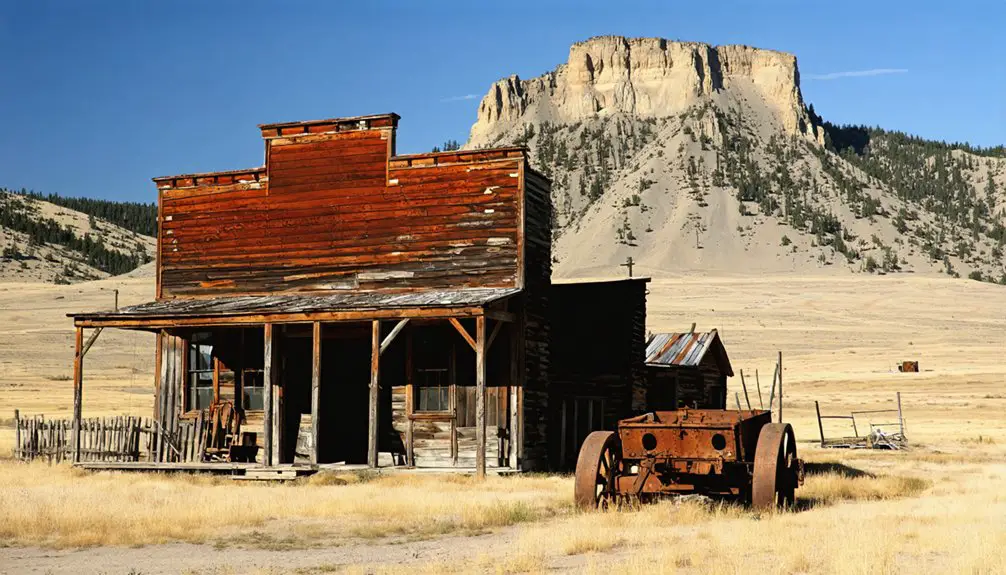
You’d find mining life in Square Butte defined by grueling daily labor, where workers faced dangerous conditions in shafts extending more than a mile underground and spanning 10,000 miles of horizontal workings.
The social fabric of the community was woven through diverse immigrant populations, with workers and their families establishing neighborhoods, schools, and churches near the mining operations. The area’s mining prowess was evident in its remarkable 210 million pounds of copper production annually by 1896.
Your daily commute would’ve relied heavily on the extensive railway networks that not only transported ore but also served as crucial arteries connecting the mining communities to the outside world.
Daily Work and Labor
As Square Butte transformed into a bustling mining center, workers faced grueling conditions in their pursuit of copper, silver, gold, and other precious metals.
Daily routines involved descending deep into dark, cramped shafts where you’d work long shifts performing specialized tasks like tunnel digging, ore removal, or operating hoists. Labor challenges included minimal ventilation, extreme heat, and constant exposure to hazardous gases and cave-in risks.
You’d find yourself traversing an intricate network of tunnels extending over a mile deep, working as a shaft sinker, drifter, or mucker.
The work demanded physical endurance as you’d haul ore through narrow passages using both manual and mechanical means. Support roles involved timbering for safety and maintaining essential water pumps, while smelter workers endured intense heat processing the extracted metals.
Mining Community Social Life
Beyond the demanding work hours, Square Butte’s mining community fostered a vibrant social fabric that defined daily life in the town.
You’d find distinct ethnic enclaves where immigrant families preserved their cultural traditions while building strong neighborhood bonds.
After shifts, miners gathered at local saloons that served as social hubs, while their families participated in community events like weekly dances, baseball games, and picnics.
Churches and fraternal organizations provided moral guidance and charitable support, creating a safety net for those in need.
Women played essential roles through domestic labor and community organizing, establishing charitable societies and educational initiatives.
The social structure centered on tight-knit family networks, with extended relatives helping one another navigate the challenges of mining life.
Railroad Transit Activities
The Butte, Anaconda & Pacific Railroad (BA & P) revolutionized mining operations by establishing essential transit arteries between Square Butte’s mines and regional smelting facilities.
You’d witness dedicated tracks and loading facilities near mines that enabled rapid movement of high-grade copper and silver ores to smelters, particularly the Anaconda facility.
The railroad’s significance extended beyond ore transport. You’d see specially designed rail cars and strategically placed stations that served the mining community’s daily needs.
Workers relied on these rail lines for commuting between housing areas and mine sites, especially during harsh weather conditions.
The transportation efficiency transformed Square Butte from an isolated camp into a thriving industrial hub, facilitating the movement of crucial supplies, equipment, and workforce that kept the mining operations running 24/7.
Understanding the Town’s Decline
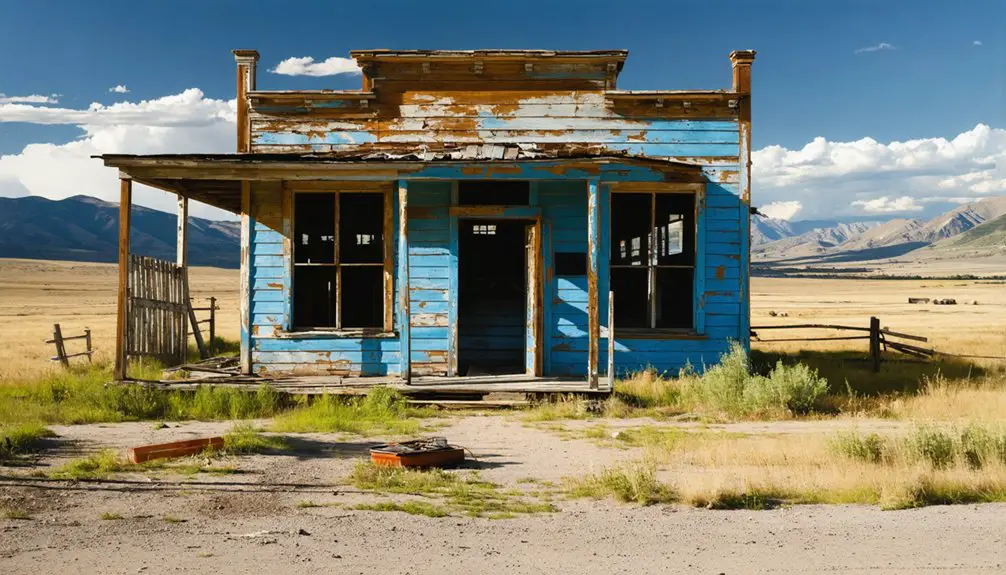
While Square Butte’s initial prosperity stemmed from gold discoveries in 1874, its eventual decline followed a complex pattern of mineral depletion and economic shifts that transformed the bustling mining town into a shadow of its former self.
Like many western boomtowns, Square Butte’s golden era faded as mineral resources dwindled and economic realities shifted.
You’ll find that the community’s economic changes mirrored many Western mining towns – early gold depletion led to silver mining, which gave way to copper operations.
As copper prices fluctuated post-World War I, the town’s fortunes waned considerably. Despite attempts at community resilience, the shift from underground to open pit mining in the mid-20th century drastically reduced local employment opportunities.
The opening of the Berkeley Pit in 1955 marked a turning point, accelerating population decline as mechanization replaced traditional mining jobs.
Exploring Present-Day Remnants
You’ll find several substantial building foundations and mining remnants throughout Square Butte, including cement rectangles, iron-reinforced structures, and shaft tops marked by cement and metal coverings.
While the Square Butte Country Club Bar remains operational as a community hub, accessing other historical structures requires traversing poorly maintained trails and washouts that limit exploration of the site. Today’s visitors must purchase a state lands use permit to legally access the area.
The mountainous terrain surrounding these remnants offers compelling photographic opportunities of both the geological features and architectural remains, though private property restrictions may affect your ability to closely examine certain areas.
Physical Structures Still Standing
Five significant structures remain standing in Square Butte, Montana, offering visitors tangible connections to this historic settlement’s past.
You’ll find the late 19th-century stone jail, a representation of frontier law enforcement and historic architecture, listed on the National Register of Historic Places. The aging brick schoolhouse stands as evidence of the town’s educational heritage, while towering grain elevators along the Milwaukee Road rail line showcase the area’s agricultural roots.
The Square Butte Country Club Bar maintains its role as a social hub, preserving structural significance from the settlement era. The abandoned café and bar remain as reminders of the town’s once-thriving commercial district.
Throughout the town, you’ll discover building foundations and ruins that reveal typical frontier construction methods, with visible remnants of wooden frames and brick chimneys marking where additional structures once stood.
Access Routes and Challenges
Reaching Square Butte’s historic remnants presents distinct navigational challenges for modern visitors.
You’ll need to travel 48 miles south of Fort Belknap Agency via Highway 66, then head 5 miles west on PowerPlant Ferry Road. The access routes cross private land before reaching public territory, requiring specific permissions and adherence to landowner restrictions.
You’ll face significant travel challenges that demand careful preparation. The site’s remote location necessitates high-clearance or 4WD vehicles, as unpaved roads become hazardous during adverse weather.
You’re restricted to designated routes, with no off-road driving permitted. Limited cellular service and minimal signage make GPS devices or detailed maps essential.
You’ll need to carry emergency supplies and extra fuel, as services aren’t readily available in this isolated area.
Photo-worthy Scenic Features
Today’s photographers and history enthusiasts discover an array of compelling subjects at Square Butte, where a dramatic flat-topped laccolith rises 2,400 feet above Montana’s plains.
You’ll find exceptional photographic techniques work best during sunrise and sunset, when natural contrasts between light and shadow emphasize the butte’s soaring buttresses and spires.
Key photo opportunities include:
- The historic jail’s locally quarried shonkinite stone against the massive butte backdrop
- Panoramic views capturing the butte’s imposing silhouette visible for 75 miles
- Historic building remnants framed by seasonal changes in vegetation
- Wildlife and native flora set against the rugged terrain’s varied textures
The ghost town’s quiet atmosphere allows for unhurried composition of shots combining both natural features and architectural heritage, creating striking visual narratives of Montana’s frontier past.
Local Legends and Ghost Stories
Square Butte’s ghost stories emerge from the dark underbelly of Montana’s mining history, where tales of restless spirits and unexplained phenomena intertwine with the region’s rugged past.
You’ll hear accounts of ghostly apparitions in period clothing wandering deserted streets and spectral encounters near abandoned mine shafts, where tragic accidents claimed countless lives.
The area’s connection to nearby Butte, once known as “The Perch of the Devil,” enriches these supernatural tales. You might encounter mysterious orbs of light, unexplained footsteps, or shadowy figures during nighttime visits.
Many stories focus on spirits from the red-light district era, similar to Butte’s famous Dumas Brothel hauntings. Local folklore also tells of hidden tunnels beneath the town, where some claim to hear phantom machinery still echoing through time.
Preservation and Access Information
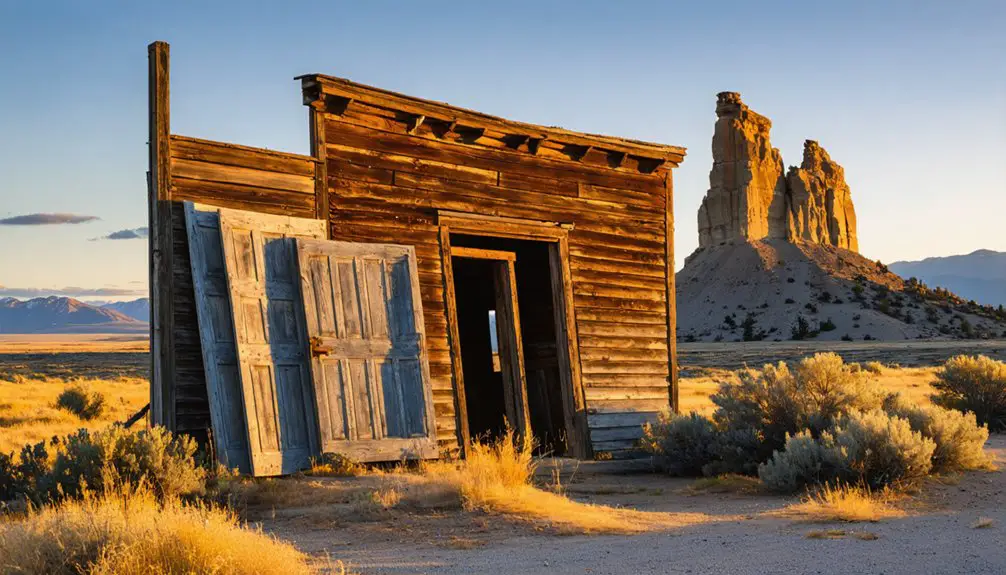
While ghostly tales bring visitors to historic sites, active preservation efforts guarantee these locations remain intact for future generations. In Montana, preservation efforts and access initiatives are coordinated through organizations like the Montana Ghost Town Preservation Society and the State Historic Preservation Office, ensuring Square Butte’s history endures.
- You’ll find extensive architectural surveys and documentation efforts that identify and protect historic structures throughout the region.
- You can access educational resources through the Butte-Silver Bow Public Archives and various museums showcasing Montana’s mining heritage.
- The National Park Service’s Paul Bruhn Grant supports essential repairs within Butte’s National Historic Landmark District.
- You’re welcome to participate in annual conventions, tours, and workshops that promote awareness and engagement with preservation practices.
Organizations actively work to maintain these historic treasures while providing you with opportunities to explore and understand Montana’s rich cultural heritage.
Frequently Asked Questions
Are There Any Remaining Descendants of Square Butte Residents Still Living Nearby?
You’ll find descendant stories uncertain without local genealogy research, though some families likely moved to Butte or Great Falls, while others may maintain agricultural connections in Montana’s central region.
What Wildlife Species Now Inhabit the Abandoned Buildings and Surrounding Area?
You’ll find rodents, bats, owls, and larger mammals like mountain lions have adapted to the abandoned ecosystem, while elk, deer, and diverse bird species thrive in surrounding grasslands and cliffs.
Was Square Butte Ever Considered as a Potential Location for Modern Development?
You won’t find evidence of Square Butte being targeted for modern development, as planning documents focus on Butte’s urban core instead. The site’s historical significance remains centered on preservation rather than redevelopment.
Did Any Famous Historical Figures Pass Through or Stay in Square Butte?
You won’t find evidence of any notable visitors or famous historical figures passing through Square Butte. Its historical significance remained local, primarily tied to railroad operations rather than attracting prominent personalities.
What Native American Tribes Originally Inhabited the Square Butte Area Before Settlement?
Primarily, you’ll find the proud Semte’use people, a Pend d’Oreille branch, were first inhabitants before settlement. Later, the Flathead and Nez Perce tribes shared cultural significance in this territory’s sacred spaces.
References
- https://southwestmt.com/blog/ghosts-of-devils-perch-a-paranormal-investigation-of-butte-montana/
- https://bigskyjournal.com/ghost-alleys-of-butte/
- https://en.wikipedia.org/wiki/Butte
- https://www.mininghistoryassociation.org/ButteHistory.htm
- https://www.youtube.com/watch?v=BQH5LghhkVs
- https://lafayettesquarearchives.com/overview-of-park-and-main/
- https://www.goldensoftware.com/solutions/real-world/ghost-town-artifacts/
- https://co.silverbow.mt.us/481/History-Culture
- https://scenariojournal.com/article/butte-montana/
- https://www.montanahikes.com/central-montana-railroads/


